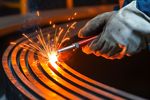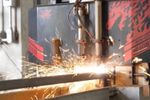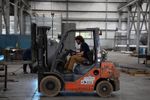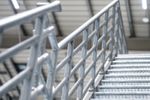In 2017 and 2018, many manufacturers felt the financial pinch from the 25 percent tariff on imported steel and the 10 percent tariff on imported aluminum. Fortunately, the metal prices roller coaster has slowed to a coast, resulting in more stable steel costs for supplier and OEMs in 2019. Manufacturers are now investing more dollars in detailing and other enhancements to improve their materials ROI, especially when it comes to steel.
Steel is still the most cost-effective material for industrial, utility, business, and residential constructions and infrastructures, thanks to its incredible durability. But steel is vulnerable to outside elements that can cause oxidation and rusting. Fortunately, experienced metal fabricators can help manufacturers and suppliers protect their steel investments with surface detailing enhancements.
Steel Fabrication ROI Is In the Details
For steel suppliers, long-term storage even in the best of circumstances can result in varying levels of oxide scale formations on steel surface areas. Descaling is often used to remove these oxides. Descaling involves complex pickling applications combined with heat, followed by scrubbing to remove the “sludge,” and then rinsing and finishing the steel in nitric-hydrofluoric acid.
Full-service metal fabricators offer numerous steel descaling services, but they can also help their customers prevent oxides from forming in the first place. When applied by professional fabricators, finishing techniques like hot-dip galvanization can add significant value to steel components. Galvanization creates a corrosion-resistant, zinc “atmosphere” around the entire steel surface, including every edge and crevice.
Hot-dip galvanization increases steel value by:
- Preparing steel for utility purposes such as electrical power transmission towers.
- Enabling outdoor constructions to withstand corrosive, inclement weather.
- Preventing strain-age embrittlement that can crack steel over time.
- Keeping working components and subassemblies intact under friction.
- Protecting industrial stairs and ladders from repetitive wear and damage.
Painting can also protect steel against the elements, but it must be applied immediately after surface prep in a controlled environment, like a paint booth. When properly applied, painting is especially useful for shielding carbon steel tanks against internal and external corrosive elements. For smaller steel fabrications like road signs or hand railings, metal powder coating protects with a more aesthetic, softer finish.
Welding the Way to Steel Fabrication ROI
Welding quality can make or break the value of a steel investment. If proper welding techniques aren’t applied before hot-dip galvanization, the zinc penetrating the weld spot can crack. If filler metal is different than the steel being joined, it can react with the zinc at a different rate for an inconsistent coating of the weld. After galvanization, electronic resistance welding can damage the zinc coating if proper welding parameters aren’t used to prevent the electrodes from getting too hot.
Experienced, full-service fabricators know how to avoid these rookie welding mistakes to ensure welds add value to each steel fabrication.
Welding QC measures that add value include:
- Welding before hot-dip galvanizing when possible, to ensure the protective zinc coating in each weld area is the same thickness as the coating on the rest of the steel part.
- Utilizing “push” rather than “pull” welding techniques for a better penetration and a flatter bead.
- Applying the correct, post-galvanization welding techniques for structures too large to fit in galvanization baths, including:
- Making sure the welds themselves are zinc-free to prevent weakening the weld area due to zinc inclusion.
- Removing the zinc coating at least one to four inches from each side of the weld zone and on both sides of the steel component.
- Grinding to remove the galvanized coating in the weld area. After the weld is complete, it must be “repaired” to ensure all the surface area is protected against corrosion.
- Ensuring these welding procedures adhere to ASTM A780 standards for repairing hot-dipped galvanized steel.
Find the Right Partner to Protect Your Steel Fabrication Investment
Partnering with an experienced, full-service metal fabricator who can design, engineer, fabricate, and finish steel structures is the first step to getting the most return on a steel investment. When all of these capabilities are housed under one roof, quality control can be monitored through the entire fabrication process, for a value-added finished product.
At Southern Metal Fabricators, we can guide your steel investment from design to delivery, with an in-house quality inspector overseeing every step. From certified welders to engineers well-versed in industrial design to state-of-the-art AutoCad, MTC Shape Cutting, and Pro Nest software, we can ensure quality control and add value to any custom steel fabrication.
Are you ready to partner with a true, full-service fabricator who can help you exceed your steel ROI expectations? Give us a chance to say, “Yes, we can do that!” by contacting us today.





